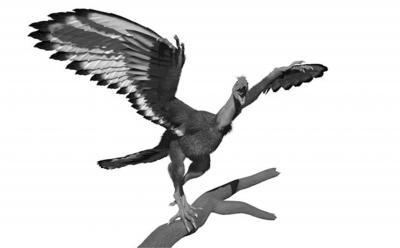X-ray experiments have found chemical traces of the original 'dinobird' Archaeopteryx and dilute traces of plumage pigments in a 150 million-year-old fossil.
Only 11 specimens of Archaeopteryx have been found, the first one consisting of a single feather. Until a few years ago, researchers thought minerals would have replaced all the bones and tissues of the original animal during fossilization, leaving no chemical traces behind, but two studies have turned up more information about this 'dinobird' and its plumage.
The first is the discovery of melanosomes; microscopic 'biological paint pot' structures in which pigment was once made, but are still visible in some rare fossil feathers. A team led by researchers at Brown University announced last year that an analysis of melanosomes in the single Archaeopteryx feather indicated it was black. They identified the feather as a covert – a type of feather that covers the primary and secondary wing feathers – and said its heavy pigmentation may have strengthened it against the wear and tear of flight, as it does in modern birds. That study examined melanosomes from locations in the fossilized feather.
Drs. Uwe Bergmann from SLAC National Accelerator Laboratory, Phil Manning and Roy Wogelius (both University of Manchester) developed a second method, this one for rapidly scanning entire fossils and analyzing their chemistry with an X-ray beam at SLAC's Stanford Synchrotron Radiation Lightsource (SSRL) in the USA (see Annual Review of Analytical Chemistry, 2012, DOI:10.1146/annurev-anchem-062011-143019).

An artist's impression of how Archaeopteryx might have looked. In black and white. Credit: University of Manchester
Over the past three years, the team used this method to discover chemical traces locked in the dinobird's bones, feathers and in the surrounding rock, as well as pigments from the fossilised feathers of two specimens of another species of early bird. This allowed the team to recreate the plumage pattern of an extinct bird for the very first time.
In the latest study, the team scanned the entire fossil of the first Archaeopteryx feather with the SSRL X-ray beam. They found trace-metals that have been shown to be associated with pigment and organic sulphur compounds that could only have come from the animal's original feathers.
"The fact that these compounds have been preserved in-place for 150 million years is extraordinary," said lead author Dr. Phil Manning. "Together, these chemical traces show that the feather was light in color with areas of darker pigment along one edge and on the tip. Scans of a second fossilized Archaeopteryx, known as the Berlin counterpart, also show that the trace-metal inventory supported the same plumage pigmentation pattern."
Co-author Dr. Roy Wogelius, said, "This work refines our understanding of pigment patterning in perhaps the most important known fossil. Our technique shows that complex patterns were present even at the very earliest steps in the evolution of birds."
The team's results show that the chemical analysis provided by synchrotron X-ray sources, such as SSRL, is crucial when studying the fossil remains of such pivotal species. The plumage patterns can begin to help scientists review their possible role in the courtship, reproduction and evolution of birds and possibly shed new light on their health, eating habits and environment.
Manning added, "It is remarkable that x-rays brighter than a million suns can shed new light on our understanding of the processes that have locked elements in place for such vast periods of time. Ultimately, this research might help inform scientists on the mechanisms acting during long-term burial, from animal remains to hazardous waste. The fossil record has potential to provide the experimental hindsight required in such studies."
The Museum für Naturkunde in Berlin (Germany) provided the Archaeopteryx fossils for analysis. Published in the Journal of Analytical Atomic Spectrometry.





Comments